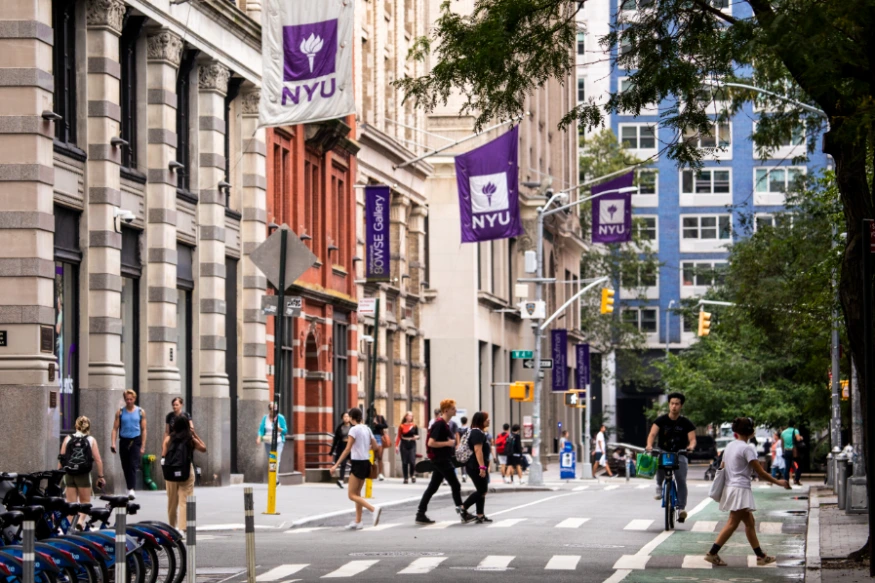
New York City remains one of the world’s top study destinations, attracting thousands of international students each year. But with prestigious universities come competitive admission rates. If you’re dreaming of studying in the Big Apple, understanding NYC acceptance rates is your first step toward making an informed decision.
Why NYC Universities Are So Competitive
New York City hosts some of America’s most prestigious institutions, making admission highly competitive. The city’s global reputation, career opportunities, and cultural diversity create a perfect storm of high demand and limited spots.
Key factors driving competition:
- World-class faculty and research opportunities
- Prime location for internships and networking
- Cultural diversity and international student community
- Post-graduation career prospects in finance, tech, and media
Major NYC Universities and Their Acceptance Rates
New York University (NYU) – 9% Acceptance Rate
NYU stands as one of NYC’s most selective institutions with only 9% of applicants gaining admission. Here’s what you need to know:
Quick Stats:
- Total applicants: 113,578 (2024)
- Students admitted: 10,693
- Average SAT: 1525 (middle 50%: 1480-1570)
- Average ACT: 34 (middle 50%: 33-35)
- International students: 34% of enrollment
What makes NYU attractive:
- Prime Manhattan location
- Strong programs in business, arts, and computer science
- Global campus network
- 88% graduation rate
Columbia University – 4% Acceptance Rate
Columbia is even more selective than NYU, accepting only 4% of applicants. As an Ivy League institution, it represents the pinnacle of academic achievement in NYC.
Key details:
- Located in Upper Manhattan
- Average SAT: 1530
- Average ACT: 35
- Strong emphasis on research and liberal arts
Other Notable NYC Institutions
Fordham University: ~58% acceptance rate The New School: ~57% acceptance rate Pace University: ~76% acceptance rate St. John’s University: ~72% acceptance rate
What Do These Numbers Really Mean?
Understanding acceptance rates goes beyond just percentages. Here’s how to interpret them:
Highly Selective (Under 15%)
Universities like NYU and Columbia fall into this category. You’ll need:
- Exceptional academic records
- Strong standardized test scores
- Compelling personal statements
- Extensive extracurricular activities
- Often, demonstrated interest in your chosen field
Moderately Selective (15-50%)
Mid-tier NYC schools offer quality education with more realistic admission chances for average students.
Less Selective (Over 50%)
These institutions provide excellent opportunities for students who may not have perfect grades but show potential and commitment.
Cost Considerations for International Students
Low acceptance rates often correlate with high costs. NYU, for example, costs approximately $30,730 per year after aid, but many international students pay the full $60,438 tuition plus living expenses.
Financial reality check:
- NYU full cost: $60,000+ annually
- Living expenses in NYC: $15,000-25,000 per year
- Total investment: $75,000-85,000 annually
Financial aid reality: Only 49% of NYU students receive aid, and international student aid is limited.
Strategies to Improve Your Chances
1. Start Early
Begin your application process at least 18 months before your intended start date. This gives you time to:
- Improve test scores through multiple attempts
- Build meaningful extracurricular experiences
- Craft compelling essays
2. Demonstrate Genuine Interest
NYC universities value students who show authentic interest in their specific programs and location.
3. Consider Alternative Entry Points
- Community college transfer: Start at a NYC community college and transfer
- Spring admission: Some programs have higher acceptance rates for spring starts
- Graduate programs: Often have different acceptance criteria
4. Apply Strategically
Don’t put all your eggs in one basket. Apply to a mix of:
- Reach schools (NYU, Columbia)
- Match schools (moderate acceptance rates)
- Safety schools (higher acceptance rates)
Beyond Acceptance Rates: What Really Matters
While acceptance rates grab headlines, smart students look deeper:
Program Quality
A 70% acceptance rate school might have a stronger program in your field than a 9% acceptance rate institution.
Career Outcomes
Research employment rates, average starting salaries, and alumni networks in your field.
Cultural Fit
NYC’s fast-paced environment isn’t for everyone. Consider if you’ll thrive in this setting.
Support Services
International student services, academic support, and mental health resources matter more than rankings.
The Truth About NYC University Life
Pros:
- Unmatched internship and job opportunities
- Diverse, international student community
- World-class cultural experiences
- Extensive alumni networks
Cons:
- Extremely high cost of living
- Intense academic and social pressure
- Limited campus life compared to traditional colleges
- Competitive atmosphere
Making Your Decision
Low acceptance rates shouldn’t discourage qualified students, but they should inform realistic planning. Consider these questions:
- Can you realistically afford 4+ years in NYC?
- Do your stats align with admitted student profiles?
- Have you considered comparable programs elsewhere?
- Is NYC essential for your career goals?
Alternative Paths to NYC
If direct admission seems unlikely:
- Transfer route: Excel at a less competitive school, then transfer
- Graduate school: Pursue undergraduate studies elsewhere, then NYC for master’s/PhD
- Study abroad programs: Spend a semester in NYC through exchange programs
Final Thoughts
NYC university acceptance rates reflect genuine competition for limited spots in one of the world’s premier study destinations. While schools like NYU’s 9% acceptance rate might seem daunting, remember that thousands of international students successfully navigate this process each year.
The key is approaching your applications strategically, with realistic expectations and strong backup plans. NYC will always be there, the question is finding the right path that leads you there.
Ready to start your NYC university journey? Research thoroughly, prepare extensively, and don’t let acceptance rates discourage you from pursuing your dreams. With proper planning and realistic expectations, studying in New York City is an achievable goal.
Planning your study abroad journey? Our team provides personalized guidance on university selection, applications, and everything you need to know about studying internationally. Contact us for expert advice tailored to your goals and budget.


